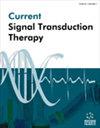Antidiabetic Advancements In Silico: Pioneering Novel Heterocyclic Derivatives through Computational Design
Q3 Medicine
引用次数: 0
Abstract
Deficiency of insulin signaling in type 2 diabetes results from insulin resistance or defective insulin secretion and induced hyperglycemia. By reducing glycated hemoglobin, SGLT2 inhibitors improve hyperuricemia, blood lipids, and weight loss without increasing the risk of hypoglycemia. By targeting this pathway, SGLT2 inhibitors can become a prominent target in the management of type 2 diabetes. This study aimed to carry out the molecular docking and ADMET prediction of novel imidazo(2,1-b)-1,3,4 thiadiazole derivatives as SGLT2 inhibitors. The chemical structures of 108 molecules were drawn by using ChemDraw Professional 15.0. Further, their energy minimization was also carried out by using Chem Bio Draw three-dimensional (3D) Ultra 12.0. Molecular docking was also carried out using a Molegro Virtual Docker to identify the best-fitting molecules and to identify the potential leads on the basis of dock score. The predicted parameters of drug-likeness according to Lipinski’s rule of five, such as molecular weight, log P, hydrogen bond acceptor, hydrogen bond donors, and number of rotatable bonds of the selected compounds, were predicted using pKCSM software. About 108 molecules were designed by employing different substitutions on imidazothiadiazole nucleus as SGLT2 inhibitors. Out of these, 10 compounds were found to have better interactions with the active site of SGLT2 protein and the highest dock scores compared to canagliflozin. Compounds 39a and 39b demonstrated good interactions and the highest docking scores of -155.428 and -142.786, respectively. The in silico physicochemical properties of the best compounds were also determined. Additionally, these compounds suggested a good pharmacokinetic profile as per Lipinski's rule of five (orally active drugs). Novel imidazo (2,1-b)-1,3,4 thiadiazole derivatives were strategically designed, and their binding affinity was meticulously evaluated against the SGLT2 protein. This endeavor yielded pioneering lead compounds characterized by ultimate binding affinity, coupled with optimal ADMET properties in adherence to Lipinski's rule of five and favourable noncarcinogenic profile.抗糖尿病的硅学进展:通过计算设计开发新型杂环衍生物
2 型糖尿病患者的胰岛素信号不足会导致胰岛素抵抗或胰岛素分泌缺陷,并诱发高血糖。通过降低糖化血红蛋白,SGLT2 抑制剂可改善高尿酸血症、血脂和体重减轻,但不会增加低血糖风险。本研究旨在对新型咪唑(2,1-b)-1,3,4 噻二唑衍生物作为 SGLT2 抑制剂进行分子对接和 ADMET 预测。此外,还使用 Chem Bio Drawthree-dimensional (3D) Ultra 12.0 进行了能量最小化。此外,还使用 Molegro VirtualDocker 进行了分子对接,以确定最佳拟合分子,并根据对接得分确定潜在的先导化合物。利用 pKCSM 软件,根据 Lipinski's rule of five 预测了所选化合物的药物相似性参数,如分子量、对数 P、氢键受体、氢键供体和可旋转键数。其中,10 个化合物与 SGLT2 蛋白的活性位点有更好的相互作用,与卡格列净相比,它们的对接得分最高。化合物 39a 和 39b 表现出良好的相互作用,对接分数最高,分别为 -155.428 和 -142.786。此外,还测定了最佳化合物的硅学理化性质。此外,根据利宾斯基五法则(口服活性药物),这些化合物具有良好的药代动力学特征。战略性地设计了新型咪唑(2,1-b)-1,3,4 噻二唑衍生物,并对其与 SGLT2 蛋白的结合亲和力进行了细致的评估。这项工作产生了先导化合物,其特点是具有极强的结合亲和力,同时还具有符合利平斯基 "五条规则 "的最佳 ADMET 特性和良好的非致癌性。
本文章由计算机程序翻译,如有差异,请以英文原文为准。
求助全文
约1分钟内获得全文
求助全文
来源期刊
CiteScore
1.70
自引率
0.00%
发文量
18
审稿时长
>12 weeks
期刊介绍:
In recent years a breakthrough has occurred in our understanding of the molecular pathomechanisms of human diseases whereby most of our diseases are related to intra and intercellular communication disorders. The concept of signal transduction therapy has got into the front line of modern drug research, and a multidisciplinary approach is being used to identify and treat signaling disorders.
The journal publishes timely in-depth reviews, research article and drug clinical trial studies in the field of signal transduction therapy. Thematic issues are also published to cover selected areas of signal transduction therapy. Coverage of the field includes genomics, proteomics, medicinal chemistry and the relevant diseases involved in signaling e.g. cancer, neurodegenerative and inflammatory diseases. Current Signal Transduction Therapy is an essential journal for all involved in drug design and discovery.

 求助内容:
求助内容: 应助结果提醒方式:
应助结果提醒方式:


